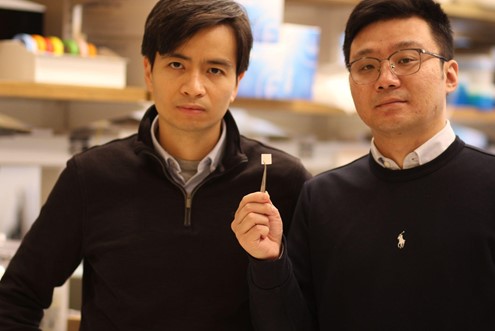Image courtesy of Thanh Nguyen.
When Professor Thanh Nguyen began his position at the University of Connecticut, he was gifted a book about electricity in the body. Nguyen, who already had experience working with electric materials, was amazed by the possibilities of using such materials in medicine. Aware of the lack of treatment options for arthritis, he wondered if an electric material could be of use.
According to the Centers for Disease Control and Prevention (CDC), nearly a quarter of all adults in the United States suffer from arthritis. Arthritis results from problems in the cartilage tissue, which is especially difficult to heal because it lacks access to blood vessels, breaking down and leading to bones rubbing together.
At present, the primary treatment for arthritis is a cartilage tissue graft placed at the site of injury. Tissue can be taken from the patient themselves or others. However, this can lead to other arthritic problems, and the patient’s body can reject foreign tissue.
Along with researcher Yang Liu, who had previous experience with tissue engineering, Nguyen began research on biodegradable piezoelectric poly-L-lactic acid (PLLA) nanofiber scaffolds as a treatment for arthritis.
“In the lab, we use a very traditional medical polymer often used for surgical suture, so it’s very safe, and transform it into a very special form so that it can produce an electrical charge when you apply force to it,” Nguyen said.
Nguyen and Liu found that this material could act as an electrical stimulator for cartilage regrowth. Electrical charge creates a friendly environment for tissue growth because it attracts stem cells, which are critical in repair. When PLLA is under pressure, such as a joint force, atom rearrangement within the scaffold creates a dipole. A huge breakthrough in the research was discovering that the negative side of this dipole better promotes the migration of stem cells.
Initial research performed by Nguyen and Liu involved placing the PLLA scaffold in the joints of rabbits. Over two months, they have witnessed promising progress towards cartilage tissue regrowth. The main question now is: will it work in humans?
Nguyen and Liu said that before clinical trials can occur, they want to explore three main issues. First, they need to see if the scaffold can survive under a load as heavy as the human body. Nguyen and Liu also need to discover how long the PLLA scaffold must be active so that the human cartilage tissue can regrow. A biodegradable material was chosen in the hopes that once the material has done its job, it will degrade and not require removal. However, this also means it must not break down until its work is complete. Finally, Nguyen and Liu explained that they want to optimize the scaffold before clinical trials, making sure that the scaffold can withstand the pressure of the human body while also emitting the optimal amount of electrical charge.
Nguyen and Liu are excited for what’s to come. In the future, they aim to research how the scaffold can be modified to treat various types of arthritis. Nguyen and Liu are hopeful to someday see these treatments realized in therapy for arthritis.

